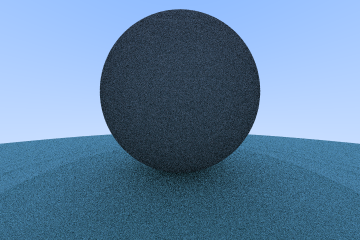6 Object Transformations
Previously we can only have one sphere at the origin since even though there’re multiple ones, we can only see one of them. In this chapter, we’ll add the functionality to transform objects in the scene and objects can be not only moved around, but also rotated and scaled.
There’re weird artifacts in the rendered image now. This may comes from incorrect transformation algorithm, but I won’t fix them now.
6.1 Affine Transformation
Just read PBRT 3.9 Transformations and PBRT 3.10 Applying Transformations. Note in the book the matrix is called ‘homogeneous’ matrix, while I just call it affine transform matrix.
6.2 Implementation Design
We use an alternative Shape implementation for primitives with transformation. This is just called Transformation, and it’s also a Primitive. A reference to the original primitive will be stored and used to implement the methods required by Shape, or more precisely, as wrappers of the inner primitive’s implementation.
By references, we can avoid copying the original primitive (as well as materials which is also stored by reference), and this could save lots memories when we have more large objects in the scene, like complicated meshes. This trick is call instancing.
6.3 Implementation
The affine transform matrix is widely used in graphics, and glam has already implemented it. Generally it’s just a \(4 \times 4\) matrix, but we’ll use glam’s Affine3A type instead of Mat4, since it’s optimized for such tasks.
#[derive(Debug, Clone, Copy)]
pub struct Transformation {
pub transformation: Affine3A,
pub inversion: Affine3A,
}Transformation functions are implemented the same way as in PBRT. As in PBRT, we store both the transformation and the inverse of the transformation so that there’s no need for recalculating.
So the transformed primitive is just a wrapper of the original primitive, along with a transformation and transformed bounding box.
#[derive(Debug, Clone)]
pub struct Transform {
pub primitive: Arc<Primitive>,
pub aabb: AABB,
pub transformation: Transformation,
}The implementation of Shape for this transformed primitive is wrapper around the inner type’s implementation. We first transform the ray using inverse transformation, i.e., transform into the local space of the primitive. Then we call the inner type’s implementation, and transform the returned result back to the world space. For intersection, this is enough, but for hit, we need to transform the result back to world space if presented:
impl Shape for Transform {
fn hit(&self, ray: Ray, rt_max: f32) -> Option<SurfaceHit> {
let (tray, trt_max) = self.transformation.transform_ray_limit_inv(ray, rt_max);
let hit = self.primitive.hit(tray, trt_max);
hit.map(
|SurfaceHit {
normal,
is_front,
ray_length: _,
position,
material,
}| {
let tp = self.transformation.transform_point(position);
let t = ray.offset(tp);
SurfaceHit {
normal: self.transformation.transform_normal(normal),
is_front,
ray_length: t,
position: ray.evaluate(t),
material,
}
},
)
}
fn intersect(&self, ray: Ray, rt_max: f32) -> bool {
let (tray, trt_max) = self.transformation.transform_ray_limit_inv(ray, rt_max);
self.primitive.intersect(tray, trt_max)
}
// ...
}Since we’re transforming from local space to world space, we use the normal transformation direction.
For convenience, we implement a lot of methods like translate or scale for Transform and Arc<Primitive>. Note you cannot actually write impl Arc<Primitive> since it’s recognized as a foreign type. The actual implementation is in the impl Shape where the self have type &Arc<Primitive>.
Now we can construct a second test scene for this chapter(one modified from Peter Shirley’s Ray Tracing in One Weekend):
fn build_two_sphere(&self, scene_config: SceneConfig) -> Scene {
let film = Film::default(scene_config.film_size.unwrap_or((720, 480)));
let mut camera_builder = Camera::builder()
.position(Vec3::new(1.8, 0.0, 0.7))
.look_at(Vec3::new(0.0, 0.0, 0.7))
.film(&film);
// Apply scene configs
// ...
let camera = camera_builder.build();
let mat1 = Arc::new(Diffuse::new(SolidColor::new(Color::new(0.5, 0.5, 0.5)).into()).into());
let mat2 = Arc::new(Diffuse::new(SolidColor::new(Color::new(0.5, 0.7, 0.7)).into()).into());
let aggregate: Aggregate = VecAggregate::from_shapes(vec![
Transform::new(
Arc::new(Sphere::new(1.0, mat1).into()),
Transformation::new(Affine3A::from_translation(Vec3::new(0.0, 0.0, 1.0))),
).into(),
Transform::new(
Arc::new(Sphere::new(1.0, mat2).into()),
Transformation::new(Affine3A::from_scale(Vec3::splat(100.0))),
).translate(Vec3::new(0.0, 0.0, -100.0)).into(),
]).into();
Scene {
film,
camera,
aggregate,
}
}And here’s my rendered result:

You may found that it runs very slow, especially under debug mode, but it’s acceptable for us.